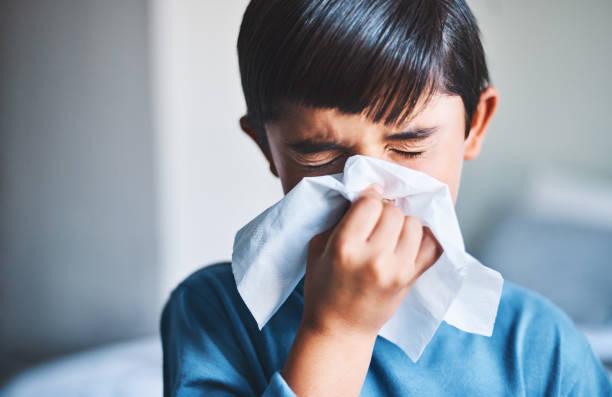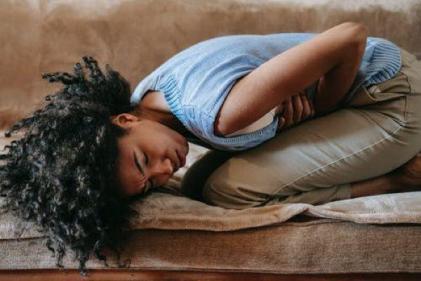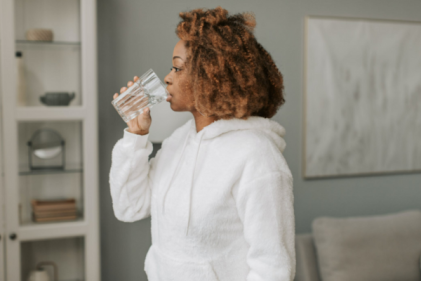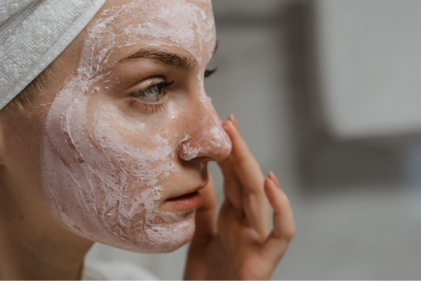While some might enjoy some of the effects of climate change here in Ireland, like milder winters and hotter summers, there are far-reaching health consequences beyond the UV index when it comes to global warming.
The prevalence of seasonal allergic rhinitis or hay fever amongst children is rising worldwide
Key Facts:
- 2023 was recorded as the hottest year ever for Ireland in 124 years, followed closely by 2022.
- Climate change is responsible for an earlier, longer and more intense pollen allergy season in Ireland. Carbon pollution continues to warm the planet and has extended the growing season for many flora and fauna. While more CO2 in the air is boosting pollen production.
- Seasonal Allergic Rhinitis or Hay Fever affects people who are allergic to one or more of the pollens produced by grass, trees or plants.
- There are more than 30 types of pollen and 20 types of spores, all of which can trigger hay fever allergy symptoms.
- The prevalence of hay fever amongst children is rising worldwide with a 6% rise to 19% amongst 13-year olds alone during a recent 8-year international study.
- A separate recent study in Cork of 6-9 year olds has shown an increase of 3% in the prevalence of hay fever to almost 11% of this age group.
- It is estimated that around 1.25 million people in Ireland suffer from hay fever, of which 20% are children.
- The most common type of asthma in children is allergic asthma, where their allergies trigger their asthma symptoms.
- New research from Climate Central, estimates that if the planet heats up by a further two degrees Celsius, it could result in a 17% annual increase in allergic related emergency room visits among asthmatic children from oak, birch, and grass pollen exposure.
- Asthma Ireland estimates that this chronic respiratory condition already costs the State around €472 million per year and is only going to rise as allergy seasons become more prolonged and intensify.
Irish Pharmacist, health advocate and hay fever sufferer, Sheena Mitchell highlights the new climate change research links to seasonal allergic rhinitis and says:
“It’s a natural conclusion that global warming would create a longer growing season for plant life. While the adaptive nature of our flora and fauna to survive climate change and produce even more pollen to counteract high CO2 levels, is scientifically amazing but devastating for allergy sufferers.”
“In the pharmacy, I am seeing patients looking for symptom relief from their Allergic Rhinitis or more commonly known as hay fever a little later than usual this year. This is largely to do with the heavier than normal rainfall we have experienced this Spring, which helps to clear the air of the pollen which causes the allergy symptoms and has delayed the season for some tree pollens.”
“However, the marked increase in overall temperatures in Ireland recorded in the last couple of years has caused high levels of tree pollen to surge as we come into summer creating what is known as a pollen bomb effect. These dangerous sudden increases in pollen levels are worrying for allergy sufferers, in particular with those who are asthmatic.”
“Children are especially sensitive to the climate change impacts of increased pollen and airborne allergens. Partly because they are still growing and developing, but also because they spend more time outdoors. Parents and caregivers will need to prepare well for this allergy season so that they can minimise the disruptive effect that hay fever can have on a child’s life. Everything is affected, from their health to their mood, sleep, schoolwork and outdoor sport participation.”
“Now is the time for the government to commit to rapid, sustained cuts to carbon pollution from burning fossil fuels. Higher levels of CO2 increase pollen production is having an irreversible negative effect on climate change.”
Hay Fever Symptoms
Allergic Rhinitis, more commonly known as hay fever, is a nasal or sinus allergic condition that affects about a quarter of all Irish people and around 20% of children. Symptoms of hay fever from the airborne pollen allergens include sneezing, coughing, a streaming or a blocked nose, sinus pain, itchy or water eyes, breathing difficulties, headaches, daytime fatigue and disturbed sleep at night.
Hay Fever Protection
Parents and caregivers can protect children’s health by helping to minimise the harmful effects of seasonal allergies in a changing climate. Key steps include:
- Respond to Symptoms, not Seasons. Children with allergies may experience symptoms earlier or later than usual as growing seasons expand and shift as our planet continues to heat up and our climate changes.
- Minimise Exposure. Check for the next day’s pollen count online using Met Eireann's pollen count tracker and try to plan your children’s day accordingly. When pollen concentrations are high, consider limiting time outdoors for children with allergies or asthma. On hot days, outdoor play at the beach is a better choice than a park. The proximity to water and the sea breeze will disperse any pollen and the salty sea air will help with respiratory symptoms.
- Create a Safe Clean Air Space Indoors. Close windows and doors to minimise aeroallergens inside. On high pollen days, use the natural salt therapy method to purify the rooms where your child will play and sleep. The Salin Plus Air Purifier device can clean the air in a room up to 55 square metres. The salt therapy air treatment is scientifically proven to provide therapeutic effects for many allergy symptoms, as well as relief for respiratory conditions like asthma and bronchitis.
- Protect Body Contact Points: Babies and children should wear wraparound sunglasses to help prevent pollen from reaching their eyes. The Hay Max Balm is a natural solution containing Aloe Vera, which is applied around your child’s nose before they go outside. This helps to catch pollen before it gets into their nasal passageways. Using a barrier moisturiser on your child, such as the La Roche Posay Lipikar balm can also be really helpful by preventing pollen from being absorbed into the skin. The Nuage Hayfever Relief wipes work by removing and trapping pollen, dust, and pet allergens. Enriched with tea tree and peppermint oil, these biodegradable wipes can be used at any age by gently wiping the face, neck and hands when exposed to pollen.
- Housekeeping Tips: Simple housekeeping tips and practices can help to prevent pollen from making its way into your home. Shake all outerwear clothing like coats that have been worn outside before coming into your home. Shower, change and wash your child’s clothes if they have been outdoors when the pollen count is high. Hair washing is also recommended as the pollen particles will cause a reaction when they fall onto their pillow at night-time.
Try not to hang clothes or bed sheets outside to dry when the pollen count is high as airborne pollen particles will land and cause allergy symptoms when brought inside. Vacuum your home regularly to try and remove any pollen particles on the floors and use a damp cloth to dust surfaces in the living space. Try to keep doors and windows closed during high pollen count days.
Keep pets as clean as possible with regular brushing and wipe downs with a damp cloth to remove pollen from their coat, particularly if you have a dog that likes to roll in grass.
Hay Fever Treatment for Children
It is very hard for children to avoid the outdoors altogether during pollen season. To help manage their allergy symptoms, there are some over-the-counter solutions that are suitable for children, depending on their age.
Daily Antihistamine: The antihistamine Zirtek oral solution is a pleasant tasting medicine and contains the active ingredients of Cetirizine. This can be taken twice daily from 2-years of age.
Irritated Eyes: Even if your child is taking a daily antihistamine, their eyes might still be a little irritated. The Fusion Allergy Cooling Mask is reusable and suitable for use by children and adults alike with its adjustable strap. Play an audio book for your child and let the hydrocool technology work its magic at relieving their hay fever symptoms of itchy, red, watery, puffy or inflamed eyes.
Opticrom Allergy Eye Drops soothes itchy and watery eyes and is suitable for any age. These eye drops contain sodium cromoglicate, which acts as an antihistamine.
Fusion Allergy Eye Drops are suitable from 12-months and come in handy single dose units. These eye drops contain Ectoin, a naturally occurring molecule produced by microorganisms that flourish in salt lakes and deserts. These eye drops provide relief from inflammation, itching and tearing eyes. They are also contact lens compatible which is important for older children and adults.
The Fusion Allergy sterile wipes use the same key ingredients and can be used on the face and eyes to cleanse eyelids and lashes and help protect from allergy induced skin irritation.
Otrivine Antistin eye drop contains an antihistamine and a decongestant, making them very effective, however they can only be used from 12-years of age.
Administering Eye Drops In Children: The best way to put eye drops into a child's eye is to tilt their head backwards, lying back on a couch is helpful. With clean washed hands, pull down the lower eyelid slightly and squeeze the drop into the space that's created.
If this method does not work with your child, then put them lying down with their eyes closed and drop some solution into the area of their eye that is between their eye and their nasal bridge. Then when they open their eyes, the little eye drop pool will spread into the eye and give them some relief.
Irritated Nose: The Sterimar Baby nasal spray can be used at any age and will help to wash allergens out of the nasal passageway, which will help reduce irritation.
Another natural alternative suitable for children from 2-years, is the A.Vogel Sinuforce nasal spray which provides rapid relief for blocked or congested noses. The 100% natural ingredients of menthol, peppermint oil and eucalyptus oil will ease breathing, while the chamomile oil has a soothing effect on their nasal mucous membranes.
Children from 3-years can use the Sterimar Stop & Protect Allergy Response nasal spray. This isotonic filtered sea water solution relieves symptoms quickly by soothing the nasal passageways. It also leaves a thin film around them which helps to stop the pollen from making contact and causing the unpleasant histamine reaction.
Another nasal spray option is Becodefence Kids and is suitable for children from 6-years of age.
Sleep: It can be very difficult for children to sleep when they’re congested with Hay Fever allergy symptoms. One natural solution that can help in the overnight period to aid breathing and sleep is salt therapy. The Salin Plus air purifier is a small fan machine that works by pushing air through a filter with micro-crystalline salts to create a fine constant spray throughout the night.
Salt therapy works through its mucolytic, antibacterial, and anti-inflammatory properties. It is also a negatively charged ion, so it stimulates the respiratory airways helping mucus to flow through the membranes. In my experience, both from patient use and my own family at home, anyone with pollen, dust or pet allergies that impact the sinus and respiratory systems will benefit hugely from this natural salt therapy when used consistently.
Tune into the WonderCare.ie Podcast for more expert advice and tips to safeguard your family’s health. Find a WonderCare Podcast on iTunes, Spotify or wherever you stream your podcasts.















